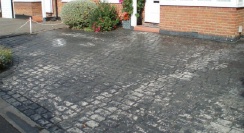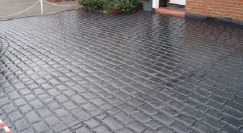CONCRETE MOISTURE PROBLEMS CAN CAUSE SEALER WHITENING
Concrete moisture problems could lead to whitening of the sealer when it's being applied to decorative concrete.
 Sealer whitening before |
 Sealer whitening after fixed |
The moisture gets trapped in or under the sealer causing a clouding or whitening effect in the film formed by the sealer.
HOW CAN CONCRETE SEALER TURNING WHITE BE AVOIDED?
Your best bet and my recommendation is to first use a deep penetrating concrete sealer that waterproofs the concrete and blocks any moisture from being absorbed into it or coming up through it from the sub-grade below.
We use RadonSeal deep penetrating concrete sealer on our floors, slabs, patios and stamped concrete. This sealer stops this kind of problem.
HERE'S SOME OF THE REASONS CONCRETE SEALER TURNS WHITE
New concrete (less than 28 days old) has a lot of moisture in it. As it drys out and cures moisture evaporates up through the concrete into the air.
Older concrete can absorb water from rain and humidity in the air, plus moisture from the sub-grade below.
Concrete kind of acts like a sponge, it's very porous, without a sealer it will absorb water. When it is dry this moisture escapes by evaporating out through the pores in the concrete. One leading problem is when the sealer comes into contact with moisture during application. Different types of sealers are designed to handle moisture depending on what category they fall under.
A cure and seal can handle higher levels of moisture allowing it to be applied to green concrete (less than 28 days old) and not turn white or cloudy.
Decorative sealers are more sensitive to moisture and should be applied after the concrete has cured (28 days or more).
If you apply a decorative sealer to concrete less than 28 days old you risk the sealer hazing or turning a cloudy white. How the sealer handles moisture passing up through it is another important consideration. The thickness of the sealer and its solvent content directly effects how moisture can escape the concrete and move up through the sealer.
All exterior sealers are designed to allow some level of moisture to escape through it (permeability) when applied by manufactures specifications.
The thinner the sealer membrane the easier moisture can pass through it without getting trapped and turning white.
The higher the solids content the more likely moisture will get trapped if you over apply the sealer. When using sealers a thin application works best.
If you use a sealer with a solvent content less than 25%, spray it on lightly, and you should avoid most moisture related problems.
If a problem does arise, misting a solvent such as xylene or acetone over the surface then back rolling it should help spread out the film formed by the sealer. After the solvents evaporate the sealer will reharden and look like new.
If this doesn't work it might be necessary to strip off the sealer, clean the surface and reapply the sealer.
For more information on other related concrete sealer topics click on the links below.
CONCRETE SEALER AND CONDENSATION PROBLEMS
CONCRETE SURFACE TEMPERATURE CAN CAUSE SEALER PROBLEMS
DEICING SALTS AND CONCRETE SEALER PROBLEMS
WHAT CAUSES SEALER BLISTERS AND BUBBLES?
SEALER SURFACE PREPARATION BEFORE SEALING
IS THERE A TINTED SEALER I CAN USE?
WHAT KIND OF SEALER APPLICATOR SHOULD I USE?
Return from Concrete Moisture Problems to Concrete Sealer
Return from Concrete Moisture Problems to Everything About Concrete Home Page














